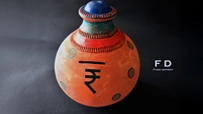Navigating the Recurring Deposit Market: How to Get Better Returns on RD
July 03, 2025

Saving money and building a corpus for the future is a goal many of us strive for. One way to achieve this is through opening a Recurring Deposit (RD) account. RDs not only help inculcate disciplined saving habits but also offer attractive interest rates, making them an ideal investment option.
In this article, we will guide you on how to navigate recurring deposit market for maximum benefits.
Understanding the Recurring Deposit Landscape
RDs are savings instruments where you deposit a fixed amount every month for a set tenure, earning guaranteed interest. Unlike Fixed Deposits (FDs) where you invest a lump sum, RDs allow you to save gradually in small monthly instalments.
Why are RDs Popular?
- Inculcate regular savings habit
- Earn higher interest than savings accounts
- Provide guaranteed returns, no market risk
- Offer flexible tenures from 6 months to 10 years
- Help save for short to medium-term goals
Navigating the Recurring Deposit Market: Step by Step
In order to navigate recurring deposit market effectively and find the best RD choices, it's important to follow these steps:
Step 1: Determine Your Financial Goals
Before you start comparing RD options, it's essential to have a clear understanding of your financial goals. Are you saving for a down payment on a house, a child's education, or a dream vacation? Knowing your goals will help you determine the tenure and investment amount necessary to achieve them.
Step 2: Conduct Market Analysis
To make informed decisions about your RD investments, it's crucial to analyse the market. Research different banks offering RD accounts, compare their interest rates, tenures, and additional features.
Look for reliable sources such as financial publications and trusted websites to gather accurate information.
Step 3: Calculate Your Potential Returns
In order to make an informed decision about which RD option is best for you, it's important to calculate the potential returns. By using a recurring deposit calculator, you can input the investment amount, tenure, and interest rate to determine the maturity amount. This will give you a clear idea of the returns you can expect.
Let's consider an example:
You want to invest ₹5,000 per month for a tenure of 3 years. Bank A offers an interest rate of 8.5% on their RDs. Using a recurring deposit calculator, you can calculate your potential returns:
Monthly Investment: ₹5,000
Tenure: 3 years
Interest Rate: 8.5%
Based on these inputs, the recurring deposit calculator shows that at the end of 3 years, your maturity amount would be ₹1,98,500.
Disclaimer: The calculation above is for illustration purposes only. Ujjivan SFB does not claim any responsibility for the accuracy of the information. For latest RD rates, kindly click here.
Step 4: Consider Additional Features
While interest rates and tenures are important factors to consider when choosing an RD account, it's also worth looking into any additional features offered by different banks.
Some banks may provide flexible options like premature withdrawal or loan against RD, which can be beneficial in certain situations.
Step 5: Make Your Decision
After conducting market analysis, calculating potential returns, and considering additional features, you're ready to make your decision. Choose the RD account that aligns with your financial goals and offers the best overall benefits.
Remember to read the terms and conditions carefully before finalising your investment.
Final Thoughts
Navigating the recurring deposit market requires careful consideration of your financial goals and conducting thorough market analysis. By following these steps and calculating potential returns, you can make informed decisions and choose the best RD choices to maximise your benefits.
Start small, dream big! Invest in Ujjivan Small Finance Bank’s Recurring Deposit and enjoy higher interest rates! Save for your long- and short-term goals with our RD and live a stress-free financial life. Start investing with just ₹100!
Disclaimer:
The contents herein are only for informational purposes and generic in nature. The content does not amount to an offer, invitation or solicitation of any kind to buy or sell, and are not intended to create any legal rights or obligations. This information is subject to updation, completion, amendment and verification without notice. The contents herein are also subject to other product-specific terms and conditions, as well as any applicable third-party terms and conditions, for which Ujjivan Small Finance Bank assumes no responsibility or liability.
Nothing contained herein is intended to constitute financial, investment, legal, tax, or any other professional advice or opinion. Please obtain professional advice before making investment or any other decisions. Any investment decisions that may be made by the you shall be at your own sole discretion, independent analysis and evaluation of the risks involved. The use of any information set out in this document is entirely at the user’s own risk. Ujjivan Small Finance Bank Limited makes no representation or warranty, express or implied, as to the accuracy and completeness for any information herein. The Bank disclaims any and all liability for any loss or damage (direct, indirect, consequential, or otherwise) incurred by you due to use of or due to investment, product application decisions made by you on the basis of the contents herein. While the information is prepared in good faith from sources deemed reliable (including public sources), the Bank disclaims any liability with respect to accuracy of information or any error or omission or any loss or damage incurred by anyone in reliance on the contents herein, in any manner whatsoever.
To know more about Ujjivan Small Finance Bank Products Visit:"https://www.ujjivansfb.in"
All intellectual property rights, including copyrights, trademarks, and other proprietary rights, pertaining to the content and materials displayed herein, belong
to Ujjivan Small Finance Bank Limited or its licensors. Unauthorised use or misuse of any intellectual property, or other content displayed herein is strictly prohibited and the same is not intended for distribution to, or use by, any person in any jurisdiction where such distribution or use would (by reason of that person’s nationality, residence or otherwise) be contrary to law or registration or would subject Ujjivan Small Finance Bank Limited or its affiliates to any licensing or registration requirements.
FAQs
1. Can I transfer my RD account from one bank to another?
No, you cannot directly "transfer" an RD from one bank to another; you would need to close your existing RD at the current bank and then open a new RD at the desired bank with the funds you receive upon maturity of the old one.
2. Can I nominate a beneficiary for my RD account?
Yes, you can nominate a beneficiary for your RD account. This ensures that in case of your demise, the funds from the RD account are transferred to the nominee.
3. Can I avail of an overdraft facility against my RD account?
Some banks offer an overdraft facility against RD accounts, allowing you to access funds up to a certain limit while still earning interest on your investment.
4. Is the interest earned from an RD account taxable?
Yes, the interest earned from an RD account is taxable as per the prevailing income tax laws in the country.
5. Can I have multiple RD accounts in different banks?
Yes, you can have multiple RD accounts in different banks based on your investment needs and preferences.
6. What happens if I don't renew my RD after maturity?
If you don't renew your RD after maturity, the bank may transfer the maturity amount to your savings account or provide other options as per their terms and conditions.
7. Can I avail a loan against my RD account?
Some banks offer loans against RD accounts as collateral. Check with your bank for more information on this facility.
8. Can I increase or decrease the monthly investment amount in an RD?
In most cases, the monthly investment amount remains fixed throughout the tenure of the RD. However, it's advisable to check with your bank for specific details.
9. Can I withdraw money from my RD account before the tenure ends?
Yes, you can withdraw money from your RD account before the tenure ends. However, doing so may result in a lower interest rate or penalty, depending on the bank's policies.
10. Are recurring deposits covered under deposit insurance?
Yes, recurring deposits of up to ₹5 lakh per depositor per bank are insured by the Deposit Insurance and Credit Guarantee Corporation (DICGC), subject to certain conditions.
Latest Blogs

How to Link PAN with Aadhaar: Step-by-Step Guide & Consequences of Not Linking
Linking your Permanent Account Number (PAN) with your Aadhaar is no longer just a best practice.

Annual Information Statement (AIS): A Complete Guide for Stress-Free ITR Filing
India’s tax season is in its final stretch.

ITR-1 (Sahaj) Restrictions: Income Sources Not Allowed & Filing Rules
With just a few days left before the 15 September 2025 deadline for filing Income Tax Returns (ITRs) for Assessment Year (AY) 2025-26, many taxpayers are rushing to submit their forms online.

GST Rate Cut on Electronics: What It Means for Consumers and Retailers
India’s Goods and Services Tax (GST) system has entered a new era with the rollout of GST 2.0, effective from September 22, 2025.

Banking Safety Guide: How to Avoid QR Code Frauds While Making Payments
India’s love for QR code payments has made transactions lightning-fast, but also opened a new front for cybercriminals.





